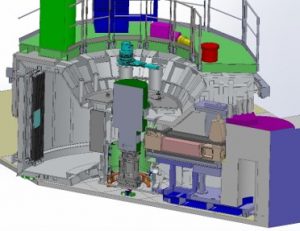In the Léon Brillouin Laboratory (LLB), and for the community of neutron scattering, this month of March 2021 was marked by an important event: the first neutron beam of the SHARP* instrument, a new time-of-flight neutron spectrometer, at the European reactor of the Institut Laue Langevin (ILL) in Grenoble.
The result of a close CEA-CNRS-ILL collaboration, with the contribution of the Franco-Swedish agreement for neutron scattering instrumentation, this new device replaces the IN6 spectrometer, installed since the mid-1980s at the Institut Laue Langevin in Grenoble.
The very first studies show that the device is fully operational and will soon be open to experimental projects.
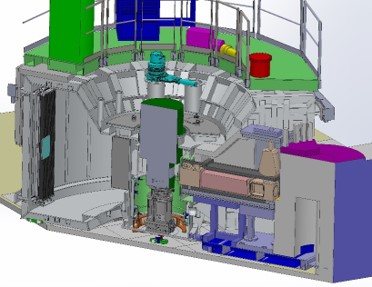
The new SHARP* spectrometer at ILL replaces the IN6 time-of-flight neutron spectrometer, which has been the reference instrument for a long time, offering the highest brightness. To optimize the use of the neutron beam, it became necessary to modernize the instrument. The operation was launched by an agreement between CEA, CNRS and ILL on September 29, 2017. The three entities then entrusted the study, the realization, and then the operation of the instrument to the Léon Brillouin Laboratory (LLB) of CEA Saclay. Its installation around the 58 MW reactor of the ILL was necessary, after the shutdown of the Orphée reactor in Saclay.
With the project thus defined, the detailed design and construction phase of the enclosure was entrusted to SDMS, a boiler making company based in St-Roman in Isère. The close collaboration between SDMS and the LLB's design office resulted in the final design of the diagram below.
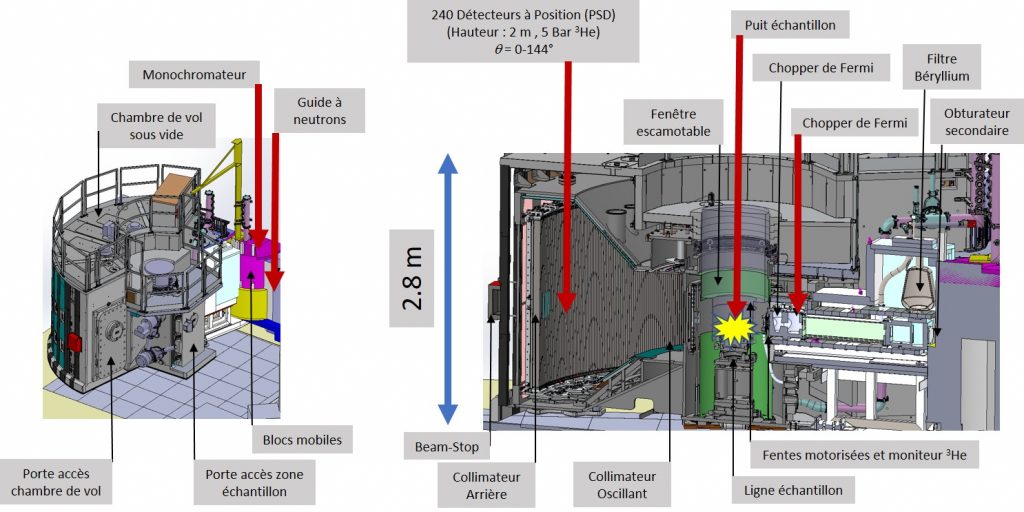
The different elements of the SHARP time-of-flight neutron spectrometer installed at ILL.
Once the boiler making was completed, the installation and equipment of the instrument was exceptionally fast, despite the context of the current epidemic: at the end of October 2020 IN6 was dismantled, and on November 30 a crane deposited the new enclosure weighing about 20 tons in the ILL guide hall via the roof. This was followed by the installation of the latest generation of neutron detectors, and packaging with high-density polyethylene protections, leading to the first effective neutron beam on 21 March 2021, a record time!
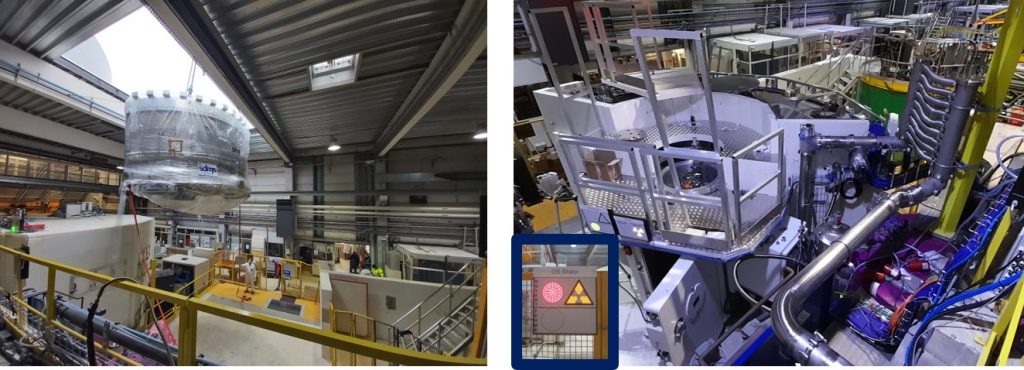
The key elements of SHARP, as the latest generation spectrometer, are :
- The neutron guide which transports the white beam of neutrons from the reactor to the inlet of the spectrometer. A monochromator allows an energy selection by Bragg reflection on a pyrolitic graphite crystal;
- From the initially continuous beam, pulses, which will interact with the sample to be studied, are produced by a “Fermi chopper”;
- 240 position detectors placed at 2.5 m from the sample allow to measure the scattered intensity over a large solid angle (146° horizontal x 46° vertical) and to measure, on each of the detectors, the time of flight of the neutrons and thus their energy. The difference in energy compared to the incident beam corresponds to the energy of an excited dynamic mode of the sample.
Studies can then begin!
Inelastic neutron scattering is an invaluable probe of microscopic dynamic events that govern the properties of matter: transport properties, magnetism, catalysis and even the function of biological objects. Crystals, soft matter, liquids… are studied in this way; for which it becomes possible to identify, for example, scattering processes, all vibrational phenomena, or phase transitions…
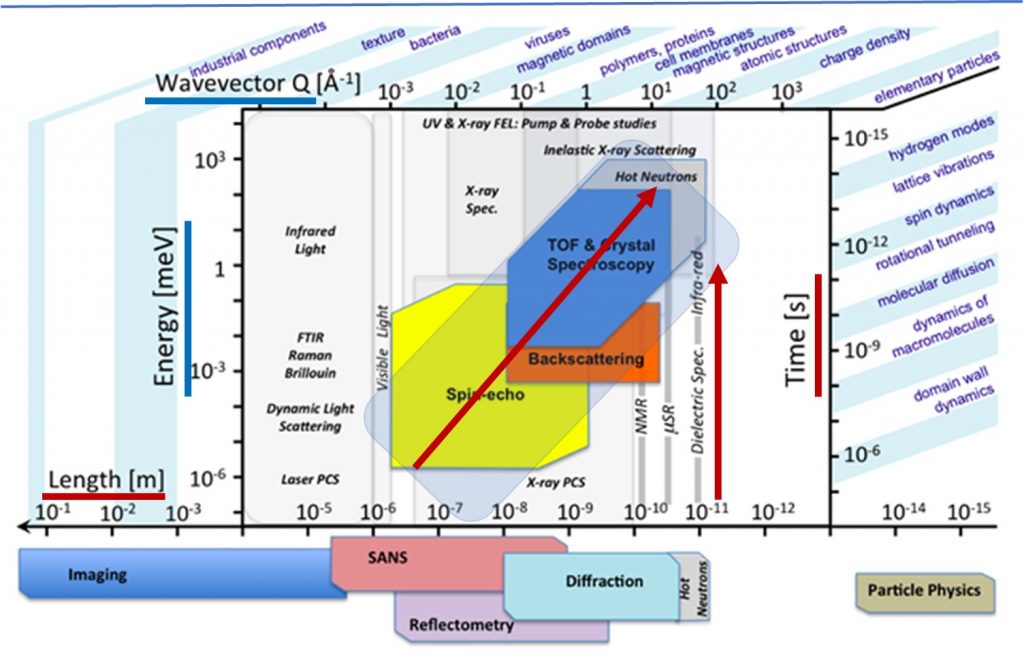
The first study carried out on SHARP was that of the magnetic modes of manganese acetate, a molecular magnet whose magnetism is carried by the manganese atoms: For the neutron scattering study, the very strong scattering of the protons of the acetate (80 barns) completely covers the magnetic signal. The neutron-matter interaction being a nuclear process, it is possible to take advantage of very strong isotopic effects by deuterating (H → D, , 80 barns → 5 barns) the organic part of the sample, thus making the magnetic signal measurable. The detectors in place at SHARP allow a perfect identification of the diffraction rings, related to the crystalline order of the material. The spectroscopic analysis “energy-vector of diffusion” allows then, by applying the principle of conservation of the moment and energy, to identify the magnetic excitations.
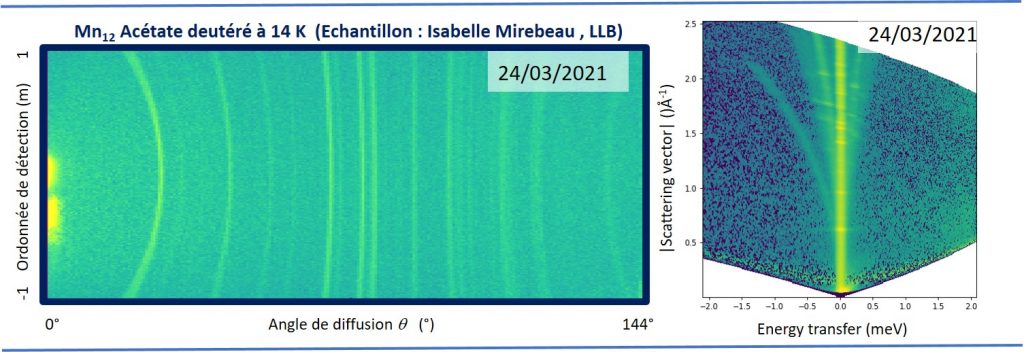
The study of the diffusion processes at the molecular scale of water in volume is a second example illustrating the performances of the device: the spectroscopic analysis “energy-vector of diffusion” of the diffusion signal shows a decrease of the diffused intensity and an energy broadening of the signal according to the diffusion vector. This behavior is well demonstrated on the profiles made at different scattering vectors. This energy dependence, therefore time dependent, of the signal as a function of the diffusion vector, i.e. of space, allow to attribute the phenomenon to a Fick diffusion process and to determine very precisely the diffusion coefficient of the molecules.

This realization would not have been possible without substantial financial support,
- first of all, the Franco-Swedish agreement for neutron scattering instrumentation, to prepare for the arrival of the European spallation source currently under construction in southern Sweden at Lund;
- and the support of CEA and CNRS, ILL and the French Federation of Neutron Diffusion (2FDN).
The support and technical teams of the LLB and ILL, as well as the support of the CEA and CNRS, supervisory authorities of the LLB, must be deeply acknowledged.
* SHARP : Spectromètre Hybride Alpes Région Parisienne (!)
Voir aussi :
- SHARP @ ILL internet Web site
- SDMS company, specialized in mechanized welding and boiler manufacturing of noble and rare metals, 38160 Saint-Romans.
- Fédération Française de Diffusion Neutronique (2FDN)
CEA contact, in charge of the SHARP spectrometer: Jean-Marc Zanotti (LLB/MMB).


